All about composters
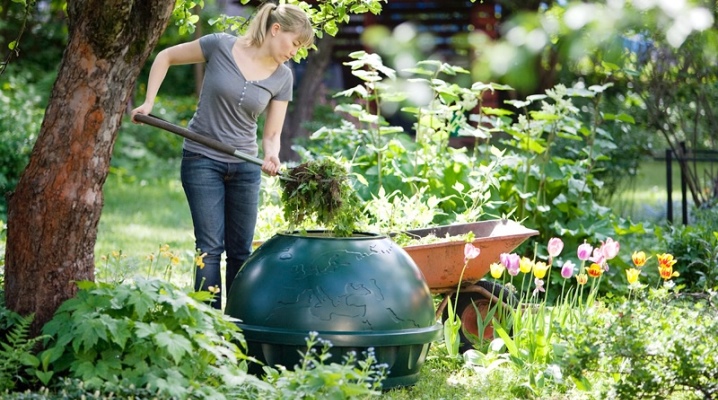
A composter is a structure for obtaining natural fertilizer - compost. In the article, we will consider the device and the principles of operation of different types of composters. And also we will understand the nuances of choosing ready-made devices and the secrets of do-it-yourself assembly.
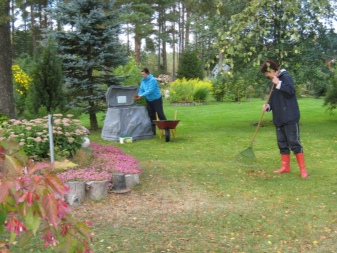
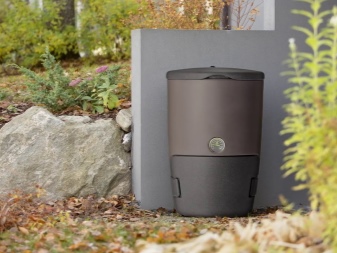
What is it and what is it for?
Compost is a fertilizer for improving soil quality, which is obtained by natural decomposition (biological oxidation) of organic waste, when organic matter breaks down into water and simpler substances (nitrogen, phosphorus, potassium) that can be easily absorbed by plants. Any parts of plants, branches, sawdust, sometimes - manure and protein, "brown" waste are used as raw materials for composting. Raw materials are collected in a mass, and in it, due to the activity of certain types of microorganisms and fungi, the processing process is started.
The resulting compost by weight is approximately 40-50% of the mass of raw materials, it looks like a loose brown substance (similar to peat) with the smell of earth. The remaining 40-50% is formed by decomposition by-products - gases and water. Thanks to composting, organic waste is recycled rather than becoming a source of environmental pollution. Useful organic matter and trace elements are returned to the soil.
The soil fertilized with compost becomes more porous, retains moisture better, it is easier for plant roots to breathe and eat in it. Obtaining such a valuable fertilizer is practically cost-free.

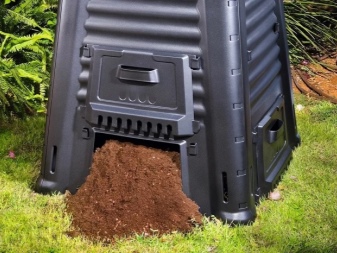
The conditions for the composting process are minimal, but they are still there.
- Temperature. If at the main stage the temperature inside the compost mass does not exceed 50-60 degrees, the compost will not be able to “mature” (therefore, the raw material is covered to keep warm). But if it is higher than 75-80 degrees, the beneficial bacteria that "make" the compost will die (therefore, the mass is mixed, ventilated, water is added).
- Humidity. In a dry environment, biooxidation will not start. At the same time, if excess water is not removed, the organic matter will start to rot.
- Aeration (ventilation) - bacteria need oxygen for their vital activity, therefore, there must be sufficient air supply not only to the edges, but also, most importantly, to the center of the composting mass. Ventilation also helps regulate the temperature.
- Mixing - provides uniform compost processing, heat distribution, ventilation.
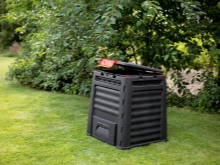
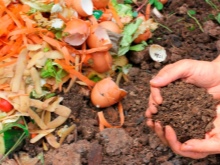
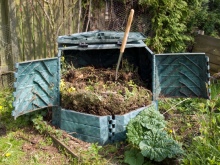
To comply with these conditions, special devices are used - composters. The simplest type of such a design is a compost heap (on large landfills - stacks, heaps, rolls). Although this method of composting is simple, it has many disadvantages - the process of decomposition in the heap is uneven, it is difficult to stir it up, it is inconvenient to pick up the finished compost, waste attracts pests, spreads odor.
A more advanced and environmentally friendly way to obtain compost in everyday life is to use special composter containers, and in industry - reactors. Their use allows you to create more comfortable conditions for the life of aerobic bacteria, various fungi, worms. The process in such devices is faster than in a compost heap, the fertilizer has a more uniform, high-quality structure.
Compost containers for the garden or at home can be made by yourself or you can buy ready-made ones.
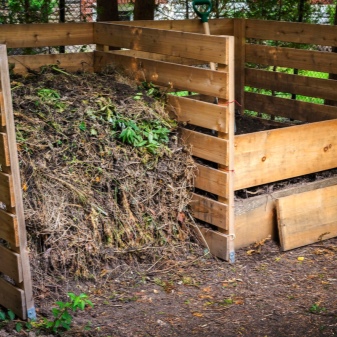
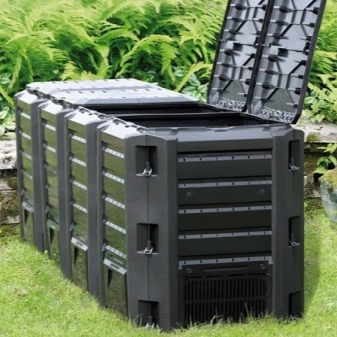
General device
Consider the general arrangement of a composter for a summer residence. The base is a box, which usually consists of four walls. The walls allow you to maintain a stable temperature inside, so the composting proceeds evenly (as opposed to a heap). The simplest garden composting bin consists only of the walls, the bottom is completely absent. Therefore, the water that forms during composting is removed naturally, and earthworms can penetrate from the soil to aid composting. Some composters are equipped with a bottom grate - it does not interfere with water and worms, but protects against uninvited guests - snakes, mice, and various pests.
Also, not all composters have a top cover, but its presence gives certain advantages - protects fertilizer from excess rain moisture, rodents, helps maintain the desired temperature inside the container. Also, the lid allows you to reduce the unpleasant odor, therefore, according to the standards, its presence is mandatory when composting protein waste (food, manure).
It is necessary to close the container from above if there are children and pets on the site. The lid is made in one piece or flap.
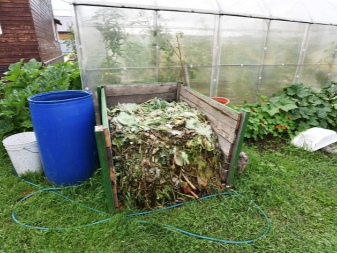
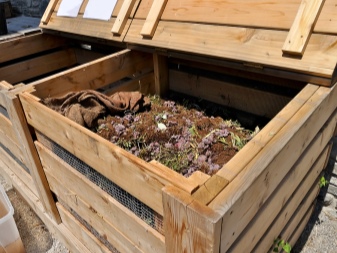
Advanced composter options can be completely sealed, keeping odor and other waste out and pests out. Special systems are used to remove liquids and gases. These containers are safe but expensive. According to the standards, containers of large volumes must have a sealed bottom so that there is no contamination of groundwater. The raw material is loaded into the composter through the upper part of the box, if it is open, or through the top cover, hatch. It is more convenient to pick up raw materials not through the top hatch, but through a special door at the bottom of the box (the compost ripens faster at the bottom).
Some models have several of these unloading hatches on each side. An alternative to the unloading hatch can be a pull-out tray or removable sections that allow the bottom layer of the stock to be unloaded. If the walls are solid (from a sheet of metal, plastic, wooden plate), ventilation holes are made in them. It is optimal that they are at several levels - this will ensure an even flow of air to the entire volume of the tank. Large sealed garden composters and industrial reactors use a ventilation tube system for aeration.
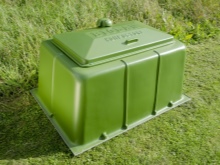
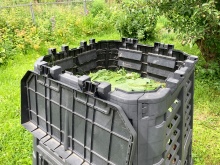
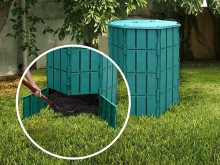
For additional convenience, on the walls of the container, in addition to the loading and unloading openings, hatches for mixing compost can be placed. In this process, special tools are used - aerators or their budget alternative - conventional pitchforks. The design of the box can be collapsible or non-collapsible. The walls of the collapsible structure are connected with latches and grooves, which allow you to quickly "fold" the box if you need to put it in a shed for the winter or transport it by car.
Composters can be either single-section or multi-section. Often they are supplied with additional devices:
- rotating shaft for easy mixing;
- thermometer - to keep track of temperature.
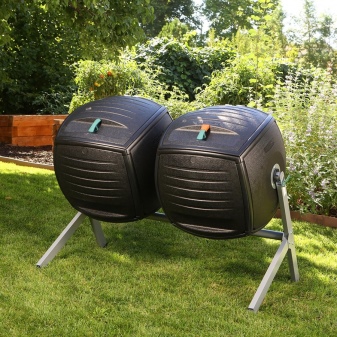
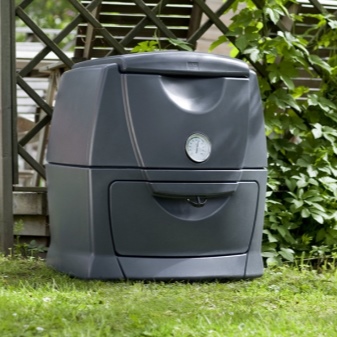
Views
In appearance, composters are open and closed.
Open
Such a composter does not have a lid, the bottom is mesh or is completely absent. Design advantages:
- good contact with the soil;
- ease of use;
- you can do it yourself.
The disadvantages are that:
- can be operated only in the warm season;
- composting is slower;
- there is an unpleasant odor;
- not suitable for processing manure and food waste, since harmful decomposition products penetrate into the soil.


Closed
A closed composter has a lid and a bottom; special hatches or systems are provided for the removal of liquids and gases. This type includes, in particular, thermocomposters.
The closed design has many advantages:
- can be used all year round, including in winter;
- the fertilizer ripens faster than in an open box;
- there are no unpleasant odors and harmful discharge;
- can be used for processing protein waste, manure;
- safe for children, animals.
Among the disadvantages:
- lack of contact with the soil;
- higher price compared to open.
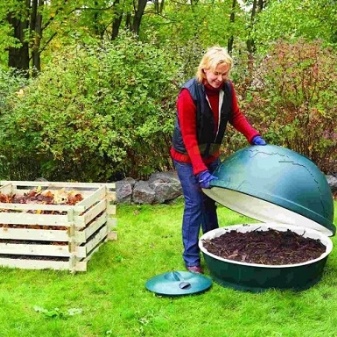
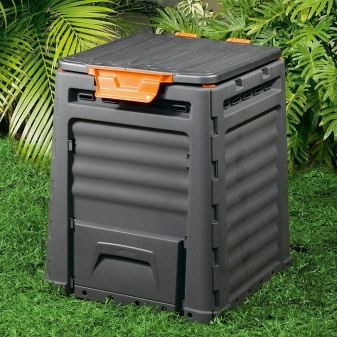
Depending on the processing technology of raw materials, it is customary to distinguish 3 types of garden composters - a box, a thermo-composter and a vermicompost. The box is the simplest model, it looks like a rectangular or cubic box. It is easy to operate, you can assemble it on your own. It can be multi-section, collapsible. Thermocomposter is a composter with a sealed, sealed body that allows you to keep heat inside like a thermos. Thanks to this, the process of compost maturation is faster, and the device can be operated in the cold season (there are models that can withstand temperatures down to -40 degrees). Typically barrel or cone shaped.
Vermicomposter is a special type of composter, where the processing of raw materials takes place with the help of earthworms. Usually consists of several trays where the worms live. The order and number of trays can be changed. The processing of raw materials at the expense of worms is carried out more slowly, but of higher quality.
If it is necessary to speed up the process, the number of "tenants" is increased, but other enzymatic accelerators cannot be used.
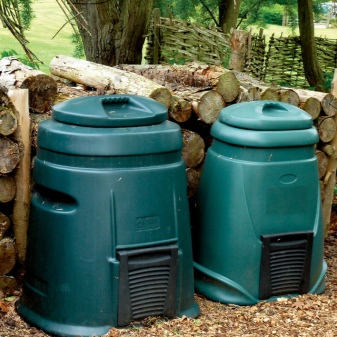
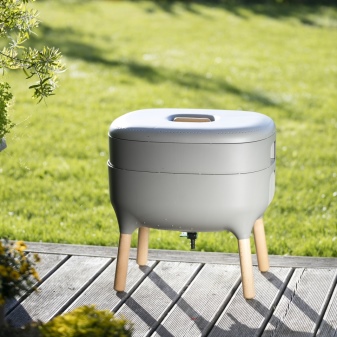
In shape, composters can be a square or rectangular box, a cone, a barrel. Sometimes the composter is made in a corner - this is convenient and saves space. But you need to remember that according to the standards (SNiP 30-02-97), the composter cannot be placed close to the fence, so as not to cause problems to neighbors. Therefore, it is best to install such a box in the backyard, but not close to the fence and residential buildings.
Plastic containers in natural shades will not spoil the appearance of the site. And for the most demanding owners there are models of landscape composters, which are made in the form of decorative elements of the landscape (stones, pyramids, cones).
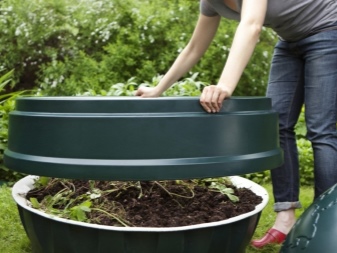
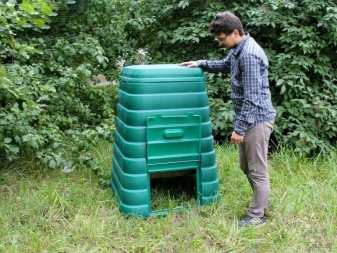
Manufacturing materials
Composting bins can be made from a variety of materials. Finished composters are usually made of plastic or metal.
- Plastic containers are more practical - they are lightweight, and even with large dimensions, it is convenient to rearrange them from place to place. Plastic looks aesthetically pleasing, it can have different colors, you can create structures from it that will fit into any landscape.
- Metal containers are heavy, it is more difficult to provide ventilation in them. But they are more durable. They hold water and heat well, so the output will be a moist fertilizer with a fairly dense consistency, which is well suited for improving depleted and loose, sandy soils. To solve the problem of ventilation, the walls of such containers are sometimes made not of a solid sheet, but of a metal mesh.
- Wooden structures are affordable and environmentally friendly. You can find them on sale or make yourself.
The main thing is that the tree needs to be protected from rotting and pests with special compounds (as a budget option, they use impregnation with machine oil).
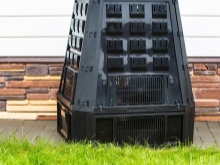
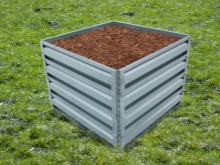
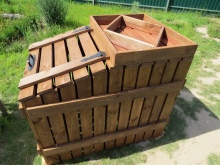
For the manufacture of a homemade container, other materials are used that are at hand. For example, it can be done:
- from large pallets (transport pallets) - they have a suitable size, the gaps between the planks, it remains only to fasten them on the sides with screws or nails;
- from slate or corrugated board - it must be borne in mind that dense monolithic sheets make it difficult to ventilate, so the compost has to be mixed more often;
- made of brick - such a structure will be durable, cells for ventilation can be provided.
Many summer residents use a large metal barrel as a container for compost. Of course, in terms of functionality, it is inferior to more complex designs, but it is fast and cheap. An analogue of a barrel is an assembly of a composter from tires. Usually 4-5 tires are cut along the tread and stacked on top of each other. It turns out a "barrel" of rubber.
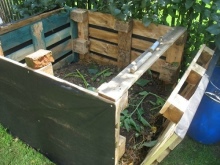
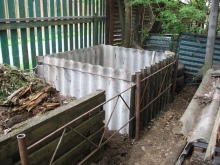
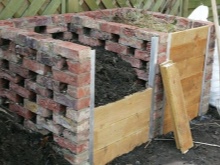
Top Models
Finnish composters produced by Kekilla, Biolan and others are the quality leaders among the finished models. These products have an attractive design, are suitable for year-round use, the compost in them matures faster due to a well-thought-out design.
Top Models - Kekilla Global (product in the form of a stylized globe, volume - 310 l) and Biolan "Stone" (construction in the form of a relief boulder, volume 450 l).
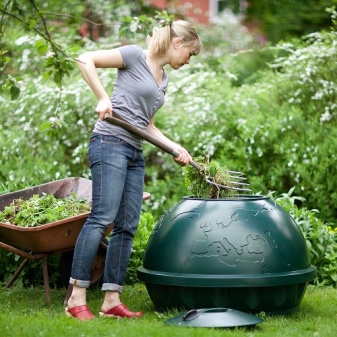
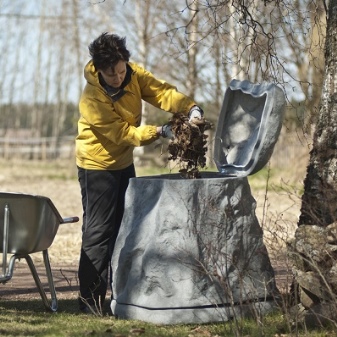
Also among the leaders are composters made in Germany. They are distinguished by high quality, good technical characteristics, durability. Models of the company performed well Graf - Graf Eco-King (400 and 600 l) and Graf Termo-King (600, 900, 1000 l).
Helex (Israel) offers devices that look like multi-colored rotating cubes mounted on a metal stand (legs). The sections are produced in volumes of 180 and 105 liters, but from the outside they seem toy and weightless. Such a design will not spoil the appearance of the site, but, on the contrary, will become its "highlight".
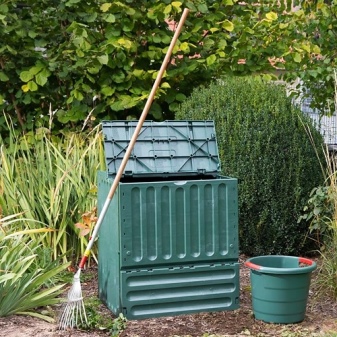

Domestic composters made of frost-resistant plastic are most in demand among Russian summer residents. They differ from foreign counterparts in a more affordable price with comparable characteristics.
The most popular models are the capacious 800 l container-composter "Urozhay", the collection container "Volnusha" for 1000 l, the wavy surface of which allows better distribution of the compost mass.
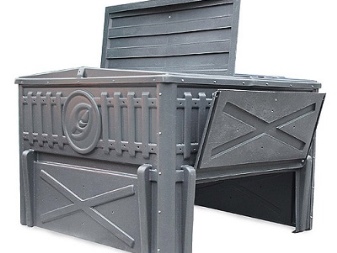
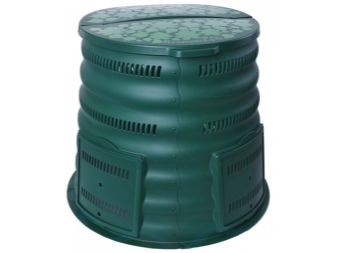
Volumetric models of garden composters allow fertilization all year round. Along with them, miniature devices for home use - EM containers - are in demand. It looks like a bucket with a sealed lid and faucet, where kitchen waste is fermented by EM bacteria into organic fertilizer. This bucket can be used in a city apartment, it does not spread the smell, it is safe.
And the resulting nutrient mixture is used for feeding indoor plants or planting in a summer cottage. This allows not only to receive useful fertilizers, but also to contribute to the preservation of the environment. EM containers are produced, usually with a volume of 4 to 20 liters.
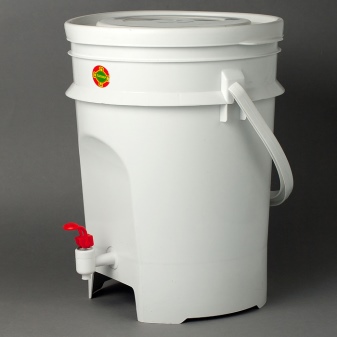
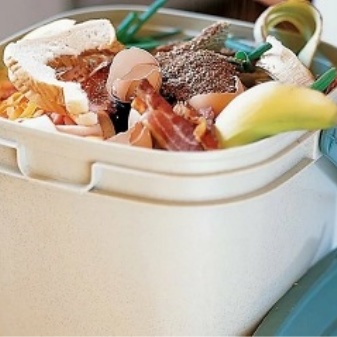
How to choose?
You need to choose a ready-made or design a homemade container based on the purposes for which it will be used. It depends on what type of container and how much volume is required.
- If the goal is the preparation of fertilizers for the garden and the processing of green waste, then the volume of the container is calculated based on the fact that for every 3 acres, one container of 200 liters in volume is required. That is, for a plot of 6 acres, a container of at least 400-500 liters is needed.
- Not every composter is suitable for year-round use, and it is better to purchase ready-made models of thermocomposters. If seasonal use is planned, you can limit yourself to a purchased or homemade box of the required volume.
- If you only need to dispose of kitchen waste, it makes no sense to buy a large tank, it is enough to purchase an EM container for your home. It can be used indoors, but the main condition is that it must be completely sealed.
- If not only green, but food, protein waste is put into the composter, it must have a lid, and ideally it must be airtight so as not to spread an unpleasant odor and not pollute the groundwater.
- If there are children, pets on the site, the model must be completely safe for them - it must not have sharp corners, it must be securely closed.
- The composter should be easy to use - it should have wide entrance and exit hatches, so that loading and unloading with a shovel can be done without any problems. The sash mountings must not open in wind gusts.
For the fertilizer to be of high quality, not to "burn out", a proper aeration system is required.

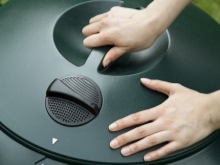

How to do it yourself?
There are many options for making a compost bin.First, you need to decide on the material of manufacture, and then prepare a drawing that will help you correctly calculate the size and amount of material. The simplest compost bin with dimensions of 1m × 1m × 1m can be assembled from wooden blocks and planks according to the following scheme.
- 4 columns are made of a 50 mm thick timber, which will be located at the corners of the composter (that is, at a distance of 1m × 1m). They are dug into the ground to a depth of 30 cm. The height is equal to the height of the box plus an additional 30 cm (in our case, 130 cm). For reliability, the posts can be fixed with cement mortar.
- Horizontal boards with a thickness of 25 mm are attached to the bars with screws or nails. The boards are not fitted tightly, but so that there are gaps of 20-50 mm for ventilation. An indent of 30-50 mm from the ground is also required.
- The lower planks can be detachable for easier retrieval of the fertilizer
- For the box, it is worth making a lid of boards. An even simpler version of the cover is a frame made of wooden boards to which the film is attached.
The number of sections can be increased if desired. If you plan to make walls from heavier materials than boards or mesh (for example, from slate, corrugated board), then it is better to assemble a composter on a metal frame. In this case, instead of supporting bars, a rack metal profile for drywall is used. From above, a frame made of such a metal profile is welded or screwed to the supports. Next, the box is sheathed with the selected material (slate, corrugated board or any other).
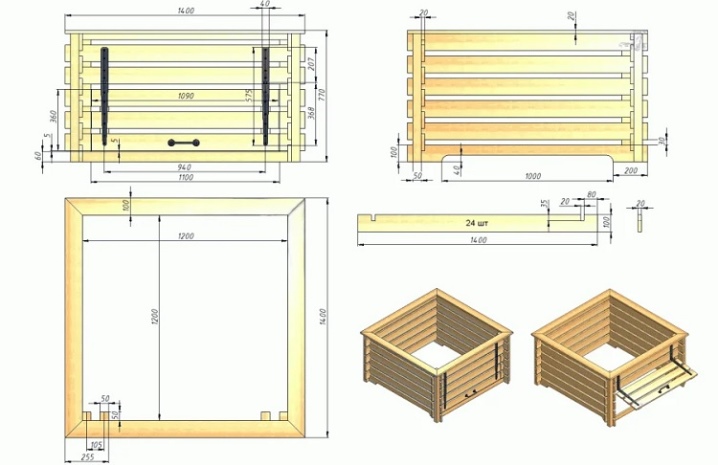
Operating tips
To use your garden composter safely and fertilizer quality, you need to follow a few simple tips:
- the container is installed in a slightly shaded place on a natural surface (ground, lawn), but not on asphalt or concrete;
- the composter must be at a distance of at least 8 m from residential buildings, wells and reservoirs (SNiP 30-02-97);
- plants affected by viruses or fungi cannot be put into the composter, they are burned;
- protein waste, manure require special composting conditions and can only be processed in closed containers;
- to improve the quality of the compost, its layers are sprinkled with peat, ash, mineral and enzymatic additives can be used;
- boxes must be protected from precipitation, for the winter they are especially carefully covered or disassembled, if the design allows;
- thermo-composters, when cold weather sets in, are transferred to winter mode, it is advisable to additionally cover them with a film;
- the compost must be mixed regularly, the humidity and temperature levels must be maintained.
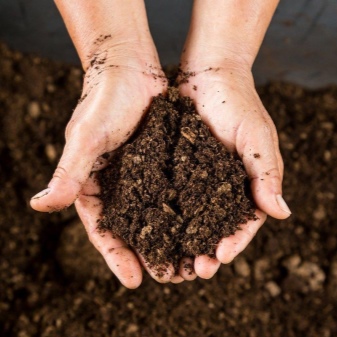
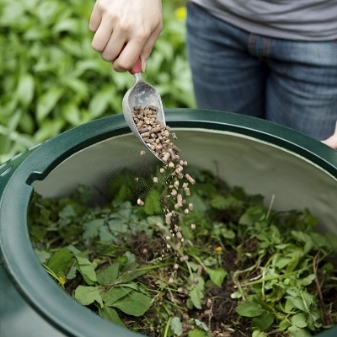
For information on how to make a budget composter with your own hands, see the next video.













The comment was sent successfully.